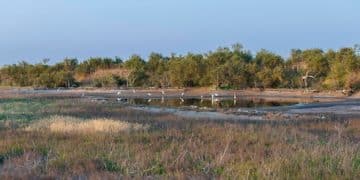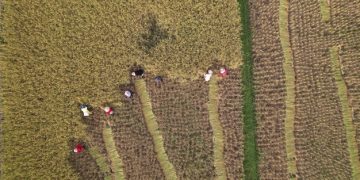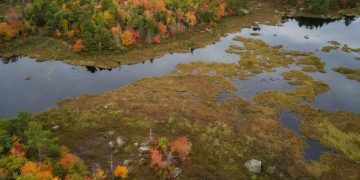US FWS Permitting: An Insider’s Guide for Conservation
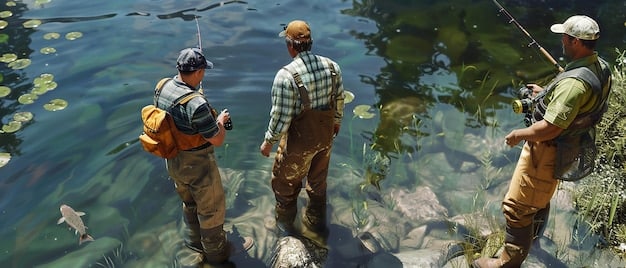
Navigating the US Fish and Wildlife Service (FWS) permitting process is crucial for conservation projects in the US, requiring a comprehensive understanding of regulations, application procedures, and compliance to ensure the protection of endangered species and their habitats.
Embarking on conservation projects in the United States often requires navigating a complex regulatory landscape. The **Insider’s Guide: Navigating the US Fish and Wildlife Service Permitting Process for Conservation Projects** is designed to provide clarity and direction, ensuring your project aligns with federal guidelines and contributes effectively to wildlife conservation.
Understanding the US Fish and Wildlife Service (FWS) Role
The U.S. Fish and Wildlife Service (FWS) plays a pivotal role in wildlife conservation. Understanding its function is key to successfully navigating the permitting process for conservation projects.
The FWS is a federal agency dedicated to conserving, protecting, and enhancing fish, wildlife, and their habitats. Its responsibilities include enforcing federal wildlife laws, protecting endangered species, managing migratory birds, and restoring significant habitats.
Key Responsibilities of the FWS
The FWS has a wide range of responsibilities all geared towards the singular goal of protecting our wildlife. Here are a few to keep in mind as you prepare your conservation project.
- Endangered Species Act (ESA) Administration: Protecting and recovering listed species and their critical habitats.
- Migratory Bird Treaty Act (MBTA) Enforcement: Regulating the take, possession, import, export, transport, selling, purchasing, or bartering of migratory birds, their eggs, parts, and nests.
- National Wildlife Refuge System Management: Overseeing a network of refuges that provide habitat for a variety of wildlife species.
- Partnerships with States and Tribes: Collaborating on conservation initiatives and providing technical and financial assistance.
The FWS’s mission is critical to maintaining biodiversity and ecological balance within the United States. When planning conservation projects, understanding these responsibilities ensures compliance with relevant regulations and promotes effective conservation practices.

Identifying the Need for an FWS Permit
Determining when a permit is needed from the U.S. Fish and Wildlife Service (FWS) is a crucial first step in conservation projects. This ensures compliance with federal regulations and avoids potential legal issues.
Many activities that impact wildlife or their habitats require authorization from the FWS. These can include projects that may affect endangered species, involve migratory birds, disturb wetlands, or impact national wildlife refuges.
Activities Requiring FWS Permits
It is important that you get any necessary permits lined up before beginning your project. Here are some activities that will require you seek a permit first.
- Projects Affecting Endangered Species: Any action that may harm, harass, or kill a listed species or modify its critical habitat requires a permit.
- Migratory Bird Activities: Scientific research, educational activities, or salvage operations involving migratory birds often need permits.
- Wetland Disturbances: Activities such as dredging, filling, or draining wetlands may require permits under Section 404 of the Clean Water Act, which the FWS often reviews.
- Import or Export of Wildlife: Permits are required for importing or exporting wildlife, including parts and products.
To accurately determine if your project needs an FWS permit, thoroughly assess the potential impact on wildlife and their habitats. Consulting with FWS regional offices or wildlife experts can provide valuable insights. Ignoring permit requirements can lead to project delays, fines, and legal challenges. By taking the time to identify permit needs upfront, projects can proceed smoothly, supporting both conservation goals and regulatory compliance.
Navigating the Endangered Species Act (ESA) Permitting
The Endangered Species Act (ESA) is a cornerstone of U.S. conservation law. Navigating the ESA permitting process is essential for any project that may affect listed species or their critical habitats.
The ESA provides protection to species designated as endangered or threatened. It prohibits the “take” of listed species, which includes harming, harassing, or killing them. Therefore, projects that may potentially impact these species require a permit.
Types of ESA Permits
There are several different types of ESA permits, each with its own purpose. Make sure you apply for the type best suited to your conservation project.
- Section 10(a)(1)(A) Permits (Recovery Permits): Issued for scientific research or enhancement of propagation or survival of listed species.
- Section 10(a)(1)(B) Permits (Incidental Take Permits): Authorized for projects that may incidentally take listed species but do not jeopardize their existence.
- Section 4(d) Rule Permits: Issued for activities that may affect threatened species, with specific regulations tailored to each species.
To secure an ESA permit, applicants must prepare a comprehensive application detailing the project’s potential impacts on listed species. This includes conducting biological surveys, assessing habitat impacts, and proposing mitigation measures to minimize harm. The FWS reviews these applications rigorously, considering the best available scientific data and conservation principles. Projects must also demonstrate that they will not jeopardize the continued existence of any listed species. By understanding the nuances of ESA permitting, conservation projects can proceed responsibly, contributing to the recovery of endangered species while meeting regulatory requirements.
Migratory Bird Treaty Act (MBTA) Permits
The Migratory Bird Treaty Act (MBTA) protects migratory birds in the United States. Understanding MBTA permits is essential for conservation projects involving these birds.
The MBTA prohibits the take, killing, possession, and transportation of migratory birds, their nests, and eggs without a permit. This act covers a vast array of bird species, making it crucial to ensure compliance when planning conservation activities.
Permit Requirements under the MBTA
Permits under the MBTA are required for a number of specific acitvities. Here are a few examples of when you’d have to secure a permit.
- Scientific Research: Permits are needed for conducting research on migratory birds, including banding, nest surveys, and behavioral studies.
- Educational Activities: Educational programs involving migratory birds often require permits to ensure the birds are handled responsibly and ethically.
- Salvage Operations: Permits allow the salvage of dead migratory birds for scientific or educational purposes.
Applying for an MBTA permit involves providing detailed information about the proposed activity, including its potential impacts on migratory birds. The FWS reviews applications to ensure that activities are conducted in a manner that minimizes harm to bird populations. Mitigation measures, such as avoiding nesting seasons and using bird-friendly materials, are often required. By obtaining the necessary MBTA permits, conservation projects can proceed legally while protecting migratory birds and contributing to their conservation. Failure to comply with the MBTA can result in significant penalties and legal repercussions.
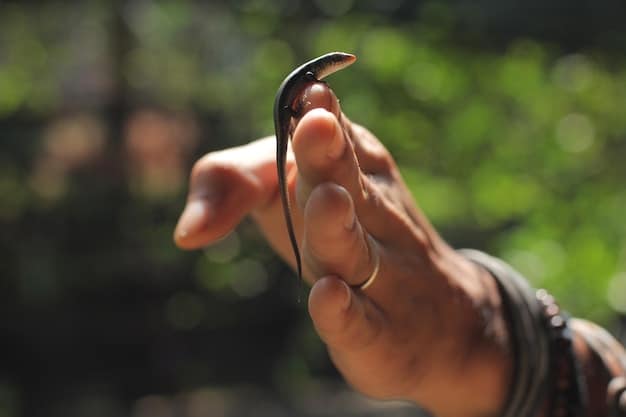
Clean Water Act Section 404 Permits and Wetlands
Section 404 of the Clean Water Act regulates the discharge of dredged or fill material into waters of the United States, including wetlands. Understanding this regulation is vital for conservation projects that may impact wetland ecosystems.
Wetlands play a crucial role in maintaining water quality, supporting biodiversity, and mitigating floods. Any activity that involves altering or disturbing wetlands requires a permit under Section 404, which is administered by the U.S. Army Corps of Engineers, often in coordination with the FWS.
Impacts on Conservation
The Clean Water Act permits have a large part to play when it comes to conservation activities. What impact do they have protecting our natural resources?
- Habitat Protection: Section 404 permits ensure that wetland ecosystems are protected from unnecessary destruction or alteration.
- Water Quality Maintenance: By regulating the discharge of pollutants, these permits help maintain the health and integrity of water bodies.
- Flood Control: Wetlands serve as natural buffers, absorbing excess water and reducing the risk of floods, a benefit preserved through permit oversight.
When applying for a Section 404 permit, applicants must demonstrate that they have taken steps to minimize impacts on wetlands and provide compensatory mitigation for any unavoidable losses. This can involve restoring or creating new wetlands to offset the impacts of the proposed activity. The FWS plays a key role in reviewing these permits, providing expertise on the ecological value of wetlands and ensuring that conservation measures are effective. By adhering to Section 404 regulations, conservation projects can proceed in a manner that protects and preserves these vital ecosystems, contributing to the overall health of the environment.
Best Practices for a Smooth Permitting Process
Navigating the U.S. Fish and Wildlife Service (FWS) permitting process can be complex. Adhering to best practices ensures a smoother and more efficient experience.
Effective preparation and communication are key to obtaining the necessary permits for conservation projects. Starting early, understanding the requirements, and engaging with the FWS can significantly reduce delays and increase the likelihood of a successful outcome.
Tips for Getting Permitted
Here are a few things you can do to make the process easier and more efficient. Securing a permit can be tricky, but with some effort, hopefully things will go smoothly.
- Start Early: Initiate the permitting process well in advance of your project’s start date.
- Understand Requirements: Thoroughly research the specific permit requirements for your project type.
- Engage with the FWS: Communicate regularly with FWS staff to clarify any questions and receive guidance.
- Prepare a Complete Application: Ensure your application is comprehensive, accurate, and includes all required documents.
- Propose Effective Mitigation: Develop mitigation measures that effectively minimize impacts on wildlife and their habitats.
By following these best practices, conservation projects can navigate the FWS permitting process effectively, fostering collaboration, responsible practices, and the ultimate success of conservation efforts. These practices not only streamline the permitting process but also contribute to building trust and cooperation between project proponents and regulatory agencies.
| Key Aspect | Brief Description |
|---|---|
| 📝 ESA Permits | Needed for projects affecting endangered species, including research and incidental take. |
| 🐦 MBTA Permits | Required for activities involving migratory birds, such as research, education, and salvage. |
| 🏞️ Section 404 | Governs activities affecting wetlands, requiring permits for discharges of dredged or fill material. |
| 🤝 Best Practices | Start early, understand requirements, engage with the FWS, and propose effective mitigation. |
Frequently Asked Questions
▼
The primary goal of the US Fish and Wildlife Service (FWS) is to conserve, protect, and enhance fish, wildlife, and their habitats for the continuing benefit of the American people.
▼
The ESA requires projects that may affect listed species or their critical habitats to obtain permits, ensuring that such projects do not jeopardize the species’ survival or recovery.
▼
Activities such as scientific research, educational programs, and salvage operations involving migratory birds typically require permits to ensure compliance with the MBTA.
▼
The FWS reviews Section 404 permits for activities affecting wetlands, providing expertise on ecological values and ensuring effective conservation measures are implemented to protect these ecosystems.
▼
To ensure a smooth FWS permitting process, start early, thoroughly understand the requirements, engage with FWS staff, prepare a complete application, and propose effective mitigation measures.
Conclusion
Successfully navigating the U.S. Fish and Wildlife Service (FWS) permitting process is essential for conservation projects. By understanding the FWS’s role, identifying permit needs, and adhering to best practices, projects can proceed responsibly, contributing to wildlife conservation while meeting regulatory requirements.
